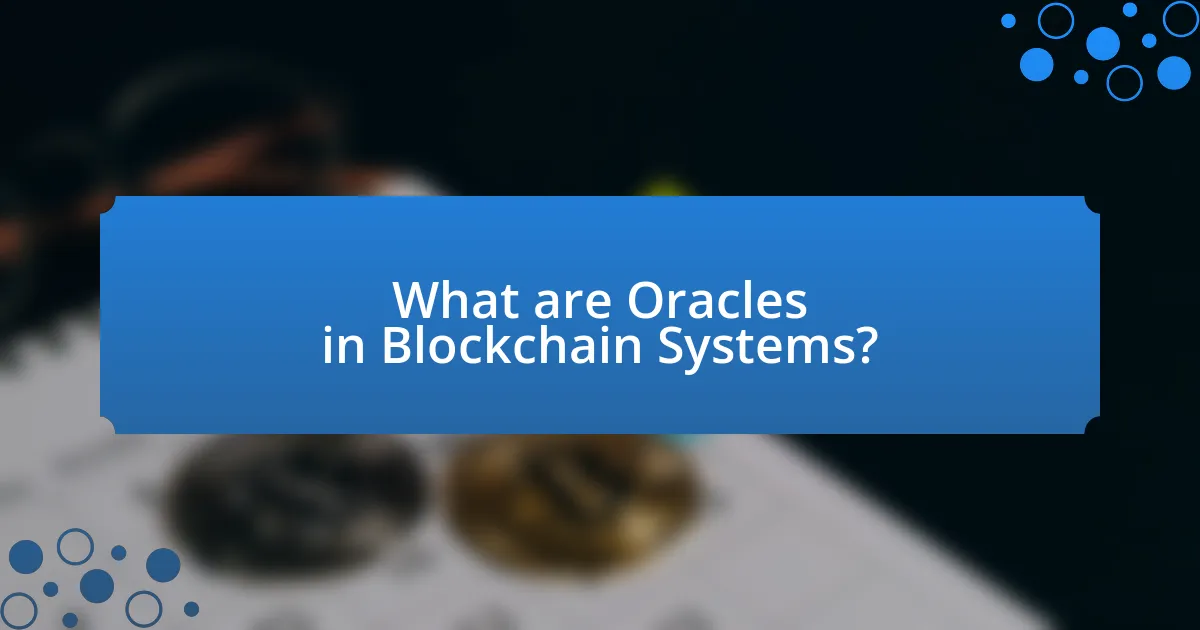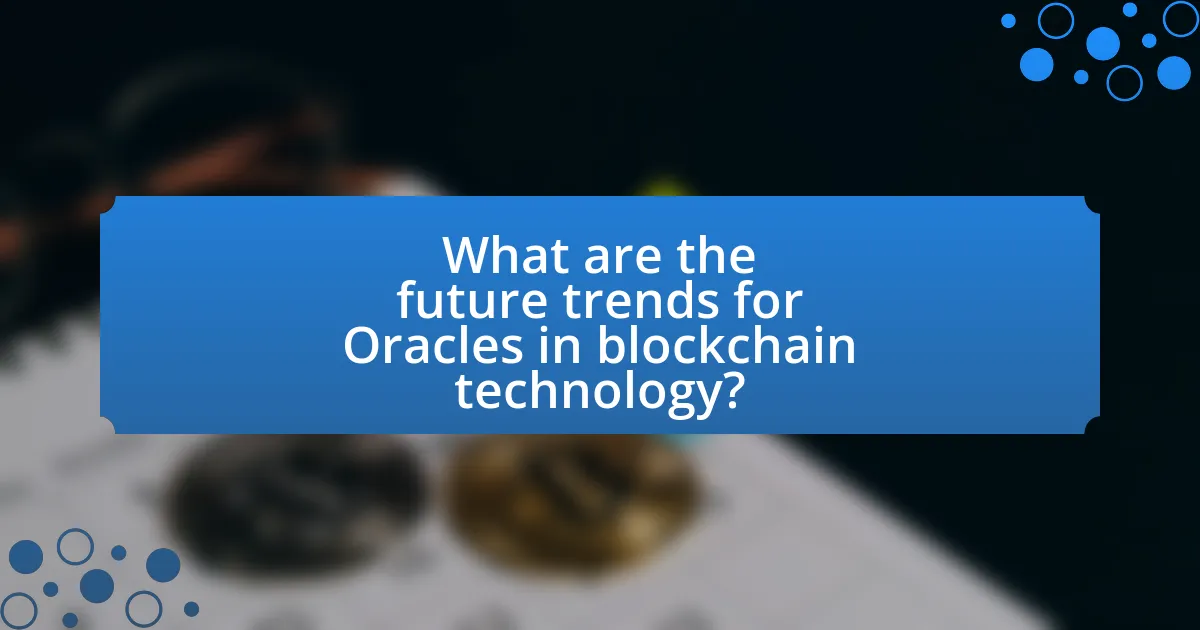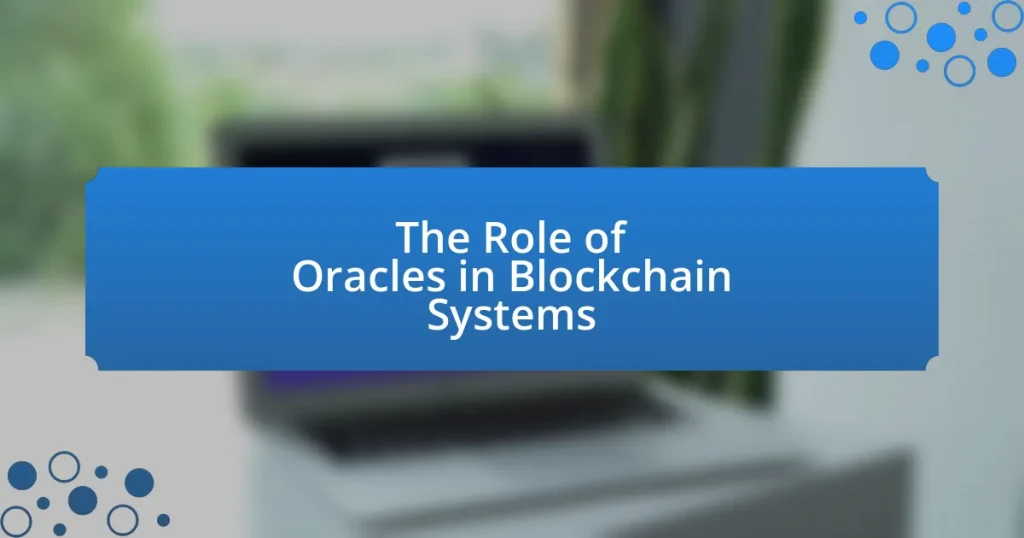Oracles are third-party services in blockchain systems that provide external data to smart contracts, enabling them to access real-world information such as market prices and weather data. This article explores the functionality of oracles, their types, and their critical role in executing smart contracts by bridging the gap between on-chain and off-chain data. It also addresses the challenges oracles face, including data accuracy, security risks, and latency issues, while discussing various categories of oracles, their integration methods with different blockchain platforms, and future trends in oracle technology. Additionally, best practices for implementing oracles and strategies for selecting reliable oracle providers are outlined to ensure effective and secure integration within blockchain applications.

What are Oracles in Blockchain Systems?
Oracles in blockchain systems are third-party services that provide external data to smart contracts on the blockchain. They act as intermediaries, enabling smart contracts to access real-world information, such as market prices, weather data, or event outcomes, which are not natively available on the blockchain. For instance, Chainlink is a well-known decentralized oracle network that aggregates data from multiple sources to ensure accuracy and reliability, thereby enhancing the functionality of blockchain applications.
How do Oracles function within blockchain ecosystems?
Oracles function within blockchain ecosystems by acting as intermediaries that provide external data to smart contracts. They enable smart contracts to access real-world information, such as market prices, weather data, or event outcomes, which is essential for executing contract conditions based on real-time data. For instance, Chainlink, a prominent decentralized oracle network, connects blockchain applications with off-chain data sources, ensuring that the information is reliable and tamper-proof. This functionality is crucial because blockchains are inherently isolated from external data, and oracles bridge that gap, allowing for more complex and useful decentralized applications.
What types of data do Oracles provide to blockchains?
Oracles provide various types of data to blockchains, including real-time market prices, weather information, and event outcomes. These data types enable smart contracts to interact with external information, facilitating automated processes based on real-world events. For example, decentralized finance (DeFi) applications rely on price oracles to ensure accurate asset valuations, while insurance protocols may use weather oracles to trigger payouts based on specific conditions. The accuracy and reliability of the data provided by oracles are crucial for the proper functioning of blockchain applications, as they bridge the gap between on-chain and off-chain information.
How do Oracles ensure data accuracy and reliability?
Oracles ensure data accuracy and reliability by utilizing multiple data sources and consensus mechanisms to validate information before it is transmitted to the blockchain. This process involves aggregating data from various trusted external sources, such as APIs and data feeds, which minimizes the risk of errors or manipulation. For instance, decentralized oracles like Chainlink employ a network of independent nodes that fetch and verify data, ensuring that the information is consistent and trustworthy. This method of cross-referencing data from multiple origins enhances the integrity of the information provided to smart contracts, thereby reinforcing the overall reliability of blockchain applications.
Why are Oracles essential for smart contracts?
Oracles are essential for smart contracts because they provide the necessary external data that enables these contracts to execute based on real-world events. Smart contracts operate on blockchain technology, which is inherently isolated from external information; thus, oracles serve as a bridge between the blockchain and the outside world. For instance, if a smart contract requires weather data to trigger a payment, an oracle can supply this information, ensuring that the contract executes accurately based on the specified conditions. Without oracles, smart contracts would be limited to the data available on the blockchain, significantly reducing their functionality and applicability in real-world scenarios.
What role do Oracles play in executing smart contracts?
Oracles serve as intermediaries that provide external data to smart contracts, enabling them to execute based on real-world information. Smart contracts, which operate on blockchain technology, require accurate and timely data inputs to function correctly; oracles fulfill this need by sourcing data from outside the blockchain, such as market prices, weather conditions, or event outcomes. For instance, in decentralized finance (DeFi), oracles like Chainlink aggregate price feeds from various exchanges to ensure that smart contracts can execute trades or liquidations based on the most current market data. This integration of external data is crucial for the reliability and effectiveness of smart contracts, as it allows them to respond to real-world events and conditions accurately.
How do Oracles enhance the functionality of decentralized applications?
Oracles enhance the functionality of decentralized applications by providing real-world data that smart contracts can utilize to execute their logic. This integration allows decentralized applications to interact with external information sources, such as financial market data, weather conditions, or event outcomes, which are essential for automating processes and ensuring accurate decision-making. For instance, Chainlink, a prominent decentralized oracle network, connects blockchain smart contracts with off-chain data, enabling applications like decentralized finance (DeFi) platforms to access price feeds and execute trades based on real-time market conditions. This capability significantly expands the use cases for decentralized applications, making them more versatile and applicable in various industries.
What challenges do Oracles face in blockchain systems?
Oracles face several challenges in blockchain systems, primarily related to data accuracy, security, and trust. Data accuracy is crucial because oracles must provide reliable information from external sources; any inaccuracies can lead to incorrect smart contract execution. Security is another significant challenge, as oracles can be vulnerable to attacks that compromise the integrity of the data they supply. Trust is also a critical issue, as decentralized systems require that participants trust the oracle’s data without a central authority to verify it. These challenges highlight the need for robust mechanisms to ensure data integrity and reliability in blockchain applications.
What are the security risks associated with using Oracles?
The security risks associated with using oracles include data manipulation, single point of failure, and reliance on external sources. Data manipulation occurs when malicious actors alter the data provided by oracles, leading to incorrect outcomes in smart contracts. A single point of failure arises when a specific oracle is compromised, which can jeopardize the entire system relying on its data. Additionally, oracles depend on external data sources, which may be unreliable or vulnerable to attacks, further increasing the risk of erroneous information being fed into blockchain applications. These risks highlight the importance of implementing robust security measures and using multiple oracles to mitigate potential vulnerabilities.
How do latency and data integrity issues affect Oracle performance?
Latency and data integrity issues significantly degrade Oracle performance by causing delays in data retrieval and processing, leading to slower transaction times and increased error rates. High latency can result in outdated or inconsistent data being presented to users, which undermines the reliability of the Oracle’s function in blockchain systems. For instance, a study by the International Journal of Computer Applications found that latency exceeding 100 milliseconds can lead to a 30% decrease in transaction throughput. Additionally, data integrity issues, such as incorrect or corrupted data, can lead to erroneous outputs, which compromise the trustworthiness of the blockchain. This is critical because oracles serve as a bridge between external data sources and smart contracts, and any failure in data integrity can disrupt the entire blockchain ecosystem.

How do different types of Oracles operate?
Different types of oracles operate by providing external data to blockchain smart contracts, enabling them to interact with real-world information. There are three main types of oracles: software oracles, hardware oracles, and consensus oracles.
Software oracles retrieve data from online sources, such as APIs, and deliver it to the blockchain, ensuring that smart contracts can access up-to-date information like market prices or weather conditions. Hardware oracles, on the other hand, connect physical devices to the blockchain, allowing data from the real world, such as sensor readings, to be used in smart contracts. Consensus oracles aggregate data from multiple sources to ensure accuracy and reliability, reducing the risk of manipulation by providing a consensus on the data being fed into the blockchain.
These operational mechanisms are crucial for the functionality of decentralized applications, as they bridge the gap between on-chain and off-chain data, facilitating a wide range of use cases in blockchain systems.
What are the main categories of Oracles?
The main categories of Oracles are centralized, decentralized, and hybrid oracles. Centralized oracles rely on a single source of data, which can create a single point of failure and trust issues. Decentralized oracles aggregate data from multiple sources, enhancing reliability and reducing the risk of manipulation. Hybrid oracles combine elements of both centralized and decentralized models, allowing for flexibility and improved data accuracy. These categories are essential for understanding how oracles function within blockchain systems, as they directly impact the security and integrity of the data being fed into smart contracts.
How do centralized Oracles differ from decentralized Oracles?
Centralized Oracles rely on a single source of data, while decentralized Oracles aggregate information from multiple sources to enhance reliability and reduce the risk of manipulation. Centralized Oracles can be faster and simpler to implement due to their singular nature, but they present a single point of failure, making them vulnerable to attacks or inaccuracies. In contrast, decentralized Oracles improve security and trustworthiness by utilizing consensus mechanisms among various data providers, thereby minimizing the risk of erroneous data affecting the blockchain. This distinction is crucial in blockchain systems, as the integrity of data inputs directly impacts the reliability of smart contracts and decentralized applications.
What are the advantages and disadvantages of each Oracle type?
There are three main types of oracles: software oracles, hardware oracles, and consensus oracles, each with distinct advantages and disadvantages.
Software oracles provide data from online sources, offering real-time information and ease of integration with smart contracts. However, they are vulnerable to hacking and data manipulation, which can compromise the integrity of the blockchain.
Hardware oracles connect physical devices to the blockchain, ensuring accurate data from the real world. Their disadvantage lies in the complexity and cost of implementation, as well as potential points of failure in the hardware itself.
Consensus oracles aggregate data from multiple sources to enhance reliability and reduce the risk of false information. The downside is that they can introduce latency and may require significant computational resources to reach consensus, impacting efficiency.
In summary, while software oracles excel in accessibility, hardware oracles ensure physical data accuracy, and consensus oracles enhance reliability, each type has inherent risks and limitations that must be considered in blockchain applications.
How do Oracles interact with various blockchain platforms?
Oracles interact with various blockchain platforms by serving as intermediaries that provide external data to smart contracts. They facilitate the connection between off-chain data sources and on-chain applications, enabling smart contracts to execute based on real-world information. For instance, decentralized oracles like Chainlink aggregate data from multiple sources to ensure accuracy and reliability, which is crucial for applications such as decentralized finance (DeFi) and insurance. This interaction is essential because blockchains are inherently isolated from external data, and oracles bridge that gap, allowing for dynamic and responsive smart contract functionality.
What are the integration methods for Oracles in different blockchains?
Oracles integrate with different blockchains primarily through three methods: on-chain oracles, off-chain oracles, and hybrid oracles. On-chain oracles directly interact with smart contracts on the blockchain, providing real-time data and triggering contract execution based on external events. Off-chain oracles gather data from external sources and relay it to the blockchain, often using APIs or data feeds, which allows for greater flexibility and access to a wider range of information. Hybrid oracles combine both on-chain and off-chain methods, enabling a more robust solution that leverages the strengths of both approaches. These integration methods are essential for enabling smart contracts to interact with real-world data, thereby expanding the functionality and applicability of blockchain technology.
How do Oracles adapt to the unique requirements of each blockchain?
Oracles adapt to the unique requirements of each blockchain by utilizing tailored data feeds and integration methods that align with the specific protocols and consensus mechanisms of the blockchain. For instance, some oracles may employ decentralized networks to ensure data integrity and reliability, while others might use APIs to fetch real-time information that meets the blockchain’s data format and security standards. This adaptability is crucial, as different blockchains, such as Ethereum and Hyperledger, have distinct operational characteristics and use cases, necessitating oracles to customize their solutions accordingly. The effectiveness of oracles in this context is evidenced by their ability to facilitate smart contracts across various platforms, ensuring that the data provided is accurate and relevant to the specific blockchain environment.

What are the future trends for Oracles in blockchain technology?
Future trends for Oracles in blockchain technology include increased integration with decentralized finance (DeFi) platforms, enhanced security measures, and the development of cross-chain oracles. As DeFi continues to grow, oracles will play a crucial role in providing real-time data for smart contracts, facilitating transactions, and ensuring accurate pricing. Enhanced security measures, such as decentralized oracle networks, will address vulnerabilities associated with single points of failure, thereby increasing trust in the data provided. Additionally, the emergence of cross-chain oracles will enable interoperability between different blockchain networks, allowing for seamless data exchange and expanding the utility of smart contracts across various ecosystems. These trends are supported by the growing demand for reliable data sources in blockchain applications, as evidenced by the increasing adoption of oracle solutions like Chainlink and Band Protocol.
How is the demand for Oracles expected to evolve?
The demand for Oracles is expected to increase significantly as blockchain technology matures and expands into various industries. This growth is driven by the need for reliable data feeds that connect smart contracts with real-world information, enabling more complex and functional decentralized applications. According to a report by MarketsandMarkets, the blockchain technology market is projected to grow from $3 billion in 2020 to over $39 billion by 2025, indicating a rising reliance on Oracles to facilitate data integration. As more businesses adopt blockchain solutions, the necessity for Oracles to provide accurate and timely data will become increasingly critical, further propelling their demand.
What innovations are being developed to improve Oracle functionality?
Innovations being developed to improve Oracle functionality include enhanced interoperability, advanced data verification mechanisms, and the integration of artificial intelligence. Enhanced interoperability allows different blockchain networks to communicate seamlessly, facilitating the exchange of data across platforms. Advanced data verification mechanisms, such as decentralized consensus algorithms, ensure the accuracy and reliability of data sourced from external environments. The integration of artificial intelligence enables Oracles to process and analyze vast amounts of data more efficiently, improving decision-making processes. These innovations are crucial for increasing the overall effectiveness and reliability of Oracles in blockchain systems.
How might regulatory changes impact the use of Oracles?
Regulatory changes may significantly impact the use of Oracles by imposing compliance requirements that affect their operation and integration within blockchain systems. For instance, if regulations mandate that Oracles must ensure data accuracy and transparency, this could lead to the development of more robust verification processes, potentially increasing operational costs and complexity. Additionally, regulations could limit the types of data Oracles can access or utilize, thereby restricting their functionality and the range of applications they can support. Historical examples, such as the introduction of GDPR in Europe, illustrate how regulatory frameworks can reshape technology practices, compelling companies to adapt their data handling and processing methods to remain compliant.
What best practices should be followed when implementing Oracles?
When implementing Oracles, it is essential to ensure data accuracy and reliability by selecting trusted data sources. Trusted data sources minimize the risk of misinformation, which is critical in blockchain applications where data integrity is paramount. Additionally, employing multiple Oracles can enhance redundancy and reduce the likelihood of a single point of failure, thereby improving overall system resilience.
Furthermore, implementing a robust validation mechanism for the data received from Oracles is crucial. This can involve cross-referencing data from multiple sources to confirm its accuracy before it is utilized within the blockchain. Regular audits of Oracle performance and data quality also contribute to maintaining high standards of reliability.
Finally, ensuring transparency in the Oracle’s operation and data sourcing fosters trust among users and stakeholders. This transparency can be achieved through open-source protocols or detailed documentation of the Oracle’s processes and data handling practices.
How can developers ensure the security of Oracle integrations?
Developers can ensure the security of Oracle integrations by implementing robust authentication and authorization mechanisms. These mechanisms include using secure API keys, OAuth tokens, and role-based access controls to restrict access to sensitive data and functionalities. Additionally, developers should regularly conduct security audits and vulnerability assessments to identify and mitigate potential risks. According to the Oracle Cloud Infrastructure Security Best Practices, employing encryption for data in transit and at rest further enhances security by protecting sensitive information from unauthorized access.
What strategies can be employed to select reliable Oracle providers?
To select reliable Oracle providers, organizations should evaluate their track record, technology compatibility, and security measures. A thorough assessment of the provider’s history, including successful implementations and client testimonials, can indicate reliability. Additionally, ensuring that the Oracle technology aligns with the specific blockchain system in use is crucial for seamless integration. Security measures, such as data encryption and compliance with industry standards, further validate the provider’s trustworthiness. According to a report by the Blockchain Research Institute, 70% of blockchain projects fail due to poor data integration, highlighting the importance of selecting a dependable Oracle provider.


